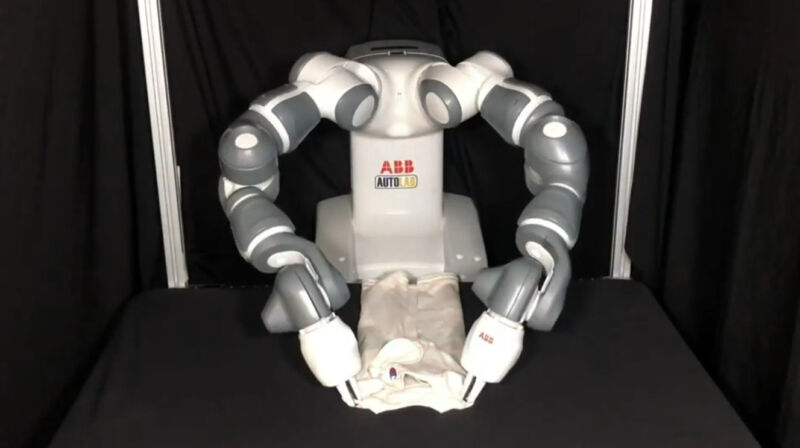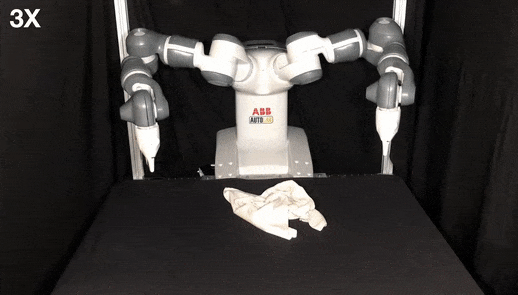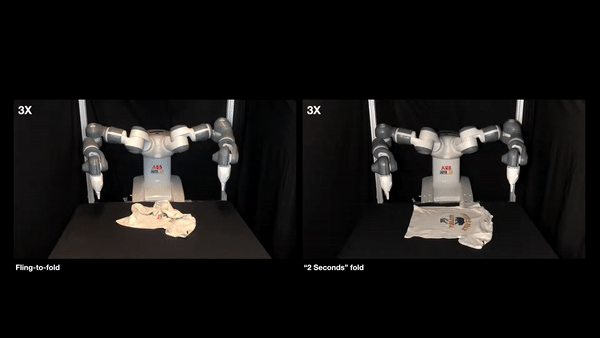Integrated with AI and flexible robotic arms, this robot can soon fold clothes instead of humans
- Tram Ho
Folding clothes is not a favorite pastime, which is probably why many scientists are looking for ways to create automatic folding machines. And researchers at AutoLab of the University of California at Berkeley have developed a robot that uses a new method to fold clothes at record speeds (in the robotics world, of course) called SpeedFolding.
Using machine vision, a neural network called the Dual Manipulation Network (BiMaMa-Net), and a pair of industrial robotic arms, SpeedFolding can fold 30–40 randomly arranged clothes per hour. On average, it usually finishes folding each one within two minutes.

SpeedFolding folding robot.
While that doesn’t sound like much for a human, previous robotic methods of folding clothes were only between 3 and 6 FPH (folds per hour). Keep in mind that these are randomly folded, even rolled up pieces of clothing, not t-shirts lying flat on the table.
Aside from the speed gains, the method the researchers described for solving the laundry-folding problem is also technically interesting. “Reliably and efficiently folding garments is a perennial challenge in the field of robotic manipulation,” they wrote. Caused by “complex dynamics” and ” large space of garment height configuration”.
In other words, clothes are prone to wrinkles and wrinkles can be everywhere. So they came up with a so-called “dual maneuver,” which uses two robotic arms to smooth out a rumpled garment first, then fold it up according to the standard fold lines given by the researchers. out.
According to the authors, previous robotic laundry methods “mainly focused on one-handed operation,” which could explain SpeedFolding’s significant speed increase.

The process of analyzing and folding the robot’s items.
The BiMaMa-Net neural network learned the ability to fold clothes after studying 4,300 human- and machine-assisted folding examples, and the test robots were able to fold clothes from a single holding position. head randomly in under 120 seconds with a 93% success rate.
Additionally, SpeedFolding can generalize (apply what it has learned) to clothing that has a different material, shape, or color than the clothing it was trained on. Basically, the system would need to check the initial state of the garment (using the overhead camera) and calculate where to grab it with the two arms to get the garment to the next desired step in the folding process.

It can also learn new folding tricks to speed up its workflow.
As for the robot’s hardware itself, the researchers used an ABB industrial robot YuMi with a gripper fingertip integrated with 3D-printed “tiny teeth” to improve its grip. A robot of this type costs about 58,000 USD, so the dream of using SpeedFolding at home is currently not within reach of a household with a normal income.
But in the future, this technique could be learned by household robots. Currently, the study’s authors mention “textile manufacturing and logistics, industrial and household laundry, healthcare and hospitality” as potential applications for this technology. For those who do not like folding and sorting clothes, it is likely that their needs will soon be addressed in the future, but for now the hands are still the best means of handling this task.
Refer to Arstechnica, Github
Source : Genk
